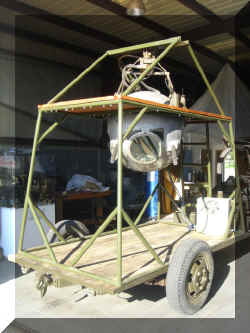Introduction
The Sperry lower ball turret was used in the Boeing B-17 Flying fortress and the Consolidated B-24 Liberator. The ball turret was mounted underneath the aircraft and was
used to defend the bomber against aircraft attacking from below.
The turret mounted two Browning 50 caliber machine guns that would fire 750 to 850 bullets in a minute , thatís about 14 bullets a second. Statistically, the ball turret was one of the safest crew positions during WWII as ball turret gunners had the lowest loss rate.
To get in the turret the gunner would manually crank the guns straight down after take off. He could then open the hatch and would climb in. Once inside he could turn on the turrets electrical and hydraulic power. The gunner would lie inside the turret in a fetal position and would sight between his legs through the circular glass. The turret was powered by an electric motor that drove two Vickers hydraulic units. One for azimuth (sideways) and one for elevation (up and down). The gunner had two handles to control the turret with.On top of these handles were the buttons for firing the guns.
Since the B-24 had very low ground clearance, a retracting mechanism was used to raise and lower the turret for take off and landing.
Taigh's Turret
The turret that we have on display at our fledgling museum at the Stockton Airport is a new old stock Sperry Bally Turret that was still mounted on its original shipping skid, and has been in sotrage since it was manufactured nearly 80 years ago. See the video we have as well, of the Sperry in action.
Note the early style glass configuration. Many of these panes were eliminated on the later ball turrets. All of the plexiglass and optical glass is original from the factory. In these photos, you can see through the round optical glass that the gunner would sight through.
One of the most unique features of this turret is that all of the original stenciling, decals and placards are fully intact. Here are the internall mounted stainless steel ammo cans with all of the factory inspection stamps and stencils still intact. The stenciled bullets were to remind the armorer which way to load the ammunition. One wonders how this particular decal came about; probably through a lesson learned the hard way. Even the quality assurance decals are still present on the turret. This turret is a study in the manufacturing process.
The above photos also show the entry hatch.When the guns pointed straight down, the gunner could get into the turret from the inside of the aircraft. When the guns were positioned horizontally, the gunner could open the hatch to the outside of the aircraft. Theoretically, the gunner could bail out of hte turret in flight. Typically, the gunner would stow his parachute inside the aircraft, so as to give him more room in the cramped turret. If the gunner had to bail out, he would turn the guns down and crawl through the fuselage to bail out from the rear hatch.
The inside of the turret is also in excellent condition. Only the padding on the armor place seat shows its age. Note the Sperry computing K-4 gunsight in the upper left corner. This was a highly advanced computer for 1942, which helped to reduce the work load of the gunner by computing lead and elevation solutions automatically. Another interesting placard is screen printed on the gunner seat. USE MODIFIED B-8 PARACHUTE. If you have any reference to this modification, please let me know.
 Jimmy Ricketts has been at it
again. Here is the finished ball turret stand that Jim built. The stand was
designed after an original WWII turret stand that I saw in storage at the
National Air and Space Museum. It was made using the same tubing size and gusset
patterns but we only put a ladder in on one side instead of both sides like the
original. The stand is sitting on top of a WWII bomb service trailer made by
Saginaw Stamping and Tool. This stand has made the ball turret fully functional
and it was taken on its maiden flight by the famous 8th Air Force ball turret
gunner Wilbur Richardson. At our Gunnery Symposium he demonstrated the ball
turret to a big crowd and then answered questions from atop the turret. It was a
great display which was made possible by Jimmy Ricketts. Thanks Jimmy for all of
your outstanding work!
Jimmy Ricketts has been at it
again. Here is the finished ball turret stand that Jim built. The stand was
designed after an original WWII turret stand that I saw in storage at the
National Air and Space Museum. It was made using the same tubing size and gusset
patterns but we only put a ladder in on one side instead of both sides like the
original. The stand is sitting on top of a WWII bomb service trailer made by
Saginaw Stamping and Tool. This stand has made the ball turret fully functional
and it was taken on its maiden flight by the famous 8th Air Force ball turret
gunner Wilbur Richardson. At our Gunnery Symposium he demonstrated the ball
turret to a big crowd and then answered questions from atop the turret. It was a
great display which was made possible by Jimmy Ricketts. Thanks Jimmy for all of
your outstanding work!
Office Manager's Note: This page will be updated with more information in the future, so please check back for that!
